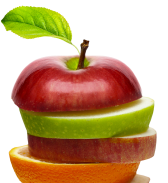This article will provide insights into the sleeping habits of Americans. We’ll dive into analytical data that reveals how much sleep Americans typically get, what factors influence sleep duration, and common bedtime rituals. By the end of this article, you’ll be more knowledgeable about the sleep patterns of Americans. In addition, let’s explore the issue of sleep problems among Americans and how they deal with it.
Sleep is an integral part of our life. Sleep is a basic physical human need that provides us with rest and recovery.
Let’s start with general scientific facts about sleep. During a normal period of sleep, a person experiences from four to six sleep cycles, according to the Physiology, Sleep Stages. article [1]. The American Academy of Sleep Medicine (AASM) and Sleep Research Society (SRS) has developed recommendations for people about how much sleep they get at different ages. Adults aged 18 to 64 need seven or more hours of sleep per night, and adults ages 65 and older need 7 to 8 hours [2].
Although doctors and scientists advise people to get sufficient sleep, many Americans still fail to do so. Gallup surveys conducted in 2013 found that 40% of Americans reported sleeping for six hours or less each night, a significant increase from 1942, when only 11% reported sleeping that little. [3]. So, the number of people who began to sleep less increased by 4 times in 70 years.
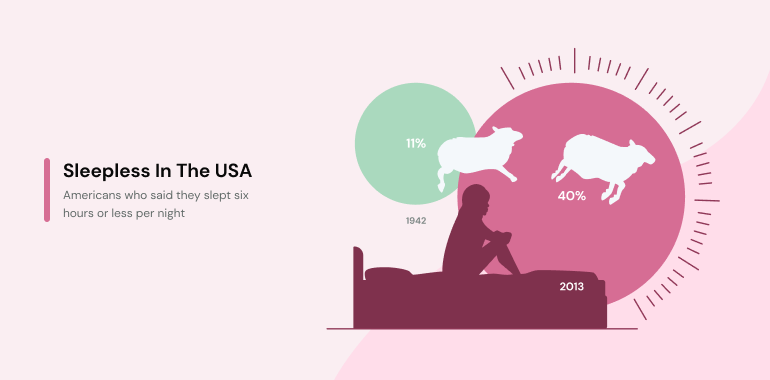
A lot of things can affect the quality of our sleep. The U.S. News & World Report Sleep Quality Survey 2022 found out what keeps Americans up at night. Many people are worried about economic, political, and environmental issues which affect their sleep. The economy is the top concern for lack of sleep – 41% of respondents worry about inflation. The pandemic still affects people’s sleep, with 39% worried about COVID-19. Gun violence in America is another concern, with 27% worrying about it. Finally, 22% of people worry about climate change and Russia’s war against Ukraine [4].
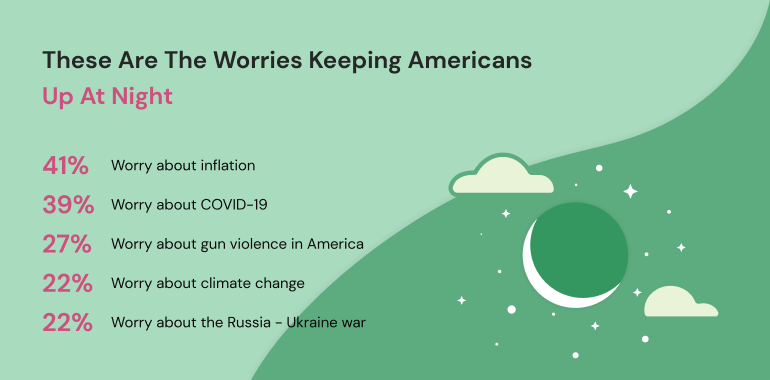
It’s interesting to note that Americans sleep differently depending on which state they live in, and this could be influenced by various factors such as economic, political, ecological, and cultural characteristics. According to the 2022 County Health Rankings & Roadmaps report by the Centers for Disease Control and Prevention (CDC), there are some states where people experience higher rates of sleep deprivation than others.
For example, Hawaii, West Virginia, and Kentucky have the highest rates of residents who sleep less than the recommended 7 hours per night at 43.2%, 42.5%, and 42.1%, respectively. On the other hand, Minnesota, Colorado, and Vermont have the lowest rates of sleep deprivation at 29.1%, 30%, and 30.1%, respectively [5].
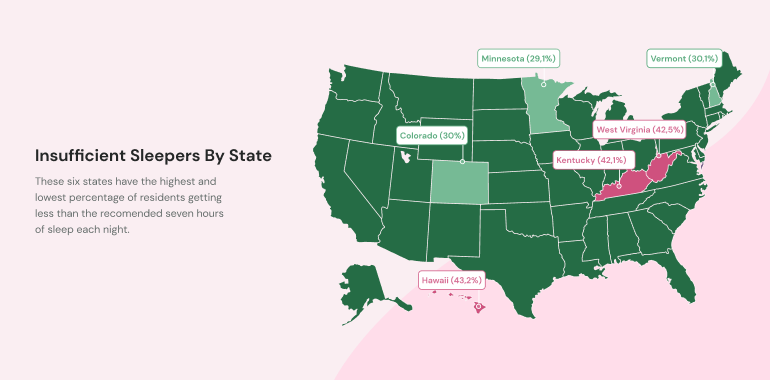
According to a survey conducted by SleepFoundation.org in August 2022, Americans reported that Sunday is the most difficult night of the week to fall asleep, with 31% of respondents saying so. The next most difficult night was Monday, with 17% of respondents reporting trouble falling asleep [6]
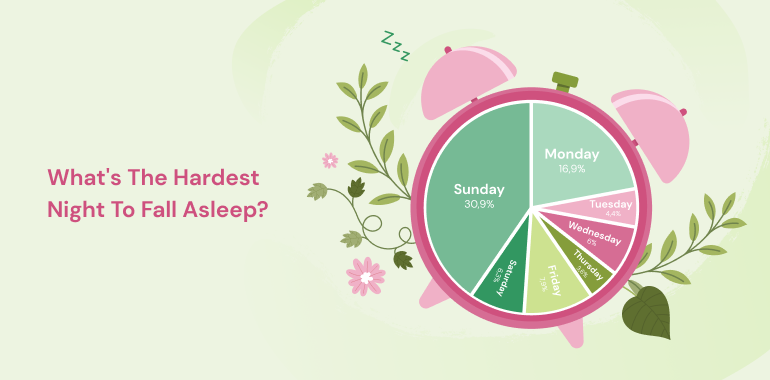
If we look at attitudes toward Sunday by gender, we see every group identifies Sunday as the most challenging day to fall asleep. It’s TOP1 for both men (31.6%) and women (30.4%), due to the SleepFoundation.org survey [6]. However, sleep difficulties on Sunday night vary by age group. The American Academy of Sleep Medicine (AASM) found that younger people have more difficulty falling asleep on Sundays than older individuals. Specifically, 31.9% of Gen Z (aged 18-25) reported that they always or often have trouble falling asleep on Sunday nights, compared to 33.9% of Millennials (26-41), 25% of Gen X (42-57), and only 9.6% of Baby Boomers (58-75). [7].
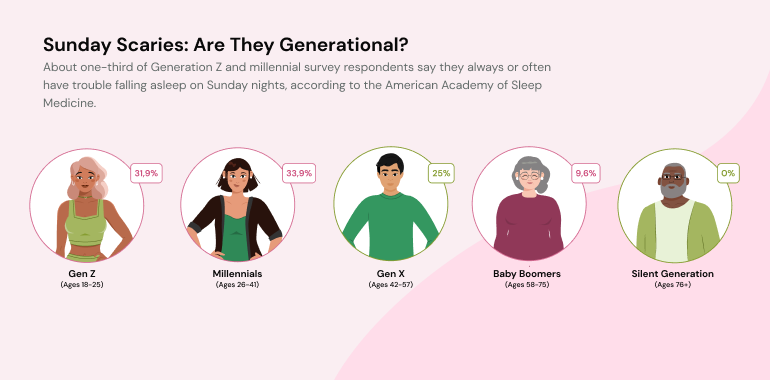
Why does Sunday scare Americans so much and make it hard for them to fall asleep? First, considering the factors that keep respondents awake on nights and they can’t sleep, due to the SleepFoundation.org survey: anxiety/stress (54.4%), general inability to feel tired (36.2%), work schedule (24.3%), noise (15%), effects of food and drink (14.4%), children (12.8%), health issues (11.8%), etc. [6]. Waiting for the start of a new work or school week affects a high level of stress and strongly affects people falling asleep on Sunday.
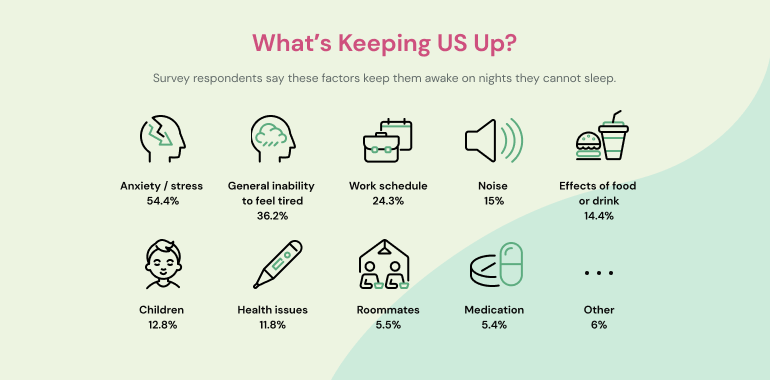
It can be difficult for people to quiet their minds and get ready for sleep, so it’s common for individuals to have specific rituals that signal to the body that it’s time to wind down. The SleepFoundation.org conducted a survey in 2022 to find out the most common bedtime rituals among Americans. The results showed that the most popular ritual is watching TV or streaming before bed, with 52.7% of respondents reporting that they engage in this activity.
Interestingly, every second (50.4%) has less than 7 hours of sleep among U.S. adults who watch TV before bed. For 32% of respondents, a shower/bath is an indispensable ritual before bed, while 58.3% of adults who shower or bathe before bed say that doing so helps them sleep. Next in the TOP are talking with a partner (22.9%) and reading a book (20.4%). In addition, consumption of specific foods (11.1%), exercise (10.6%), and yoga (9.6%) are also on the TOP [8].
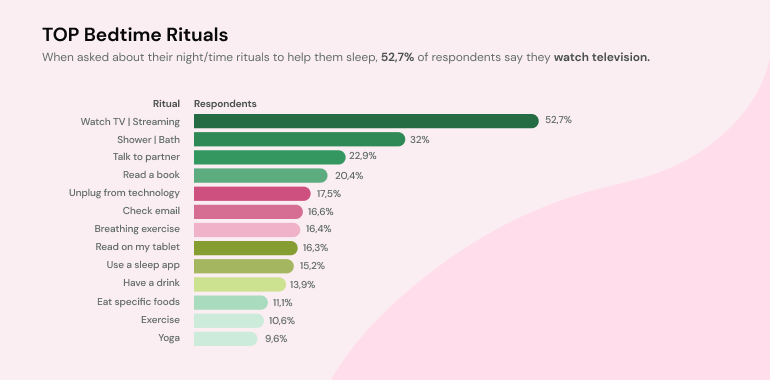
Speaking of snacking before bed, it’s worth noting that Americans average snack 3.9 nights each week, according to a February 2023 survey by OneCare Media. The respondents who snack on nuts, seeds, popcorn, and fruit may sleep 30 more minutes each night than those who snack on sugary and salty snacks [9].
We spend a lot of time on the phone, so it’s interesting; what do we scroll on before going to sleep? YouTube is the social network leader in terms of time used before bed. They spend 48 minutes on average. Then there are social networks like Facebook, Tik Tok, and Instagram [9].
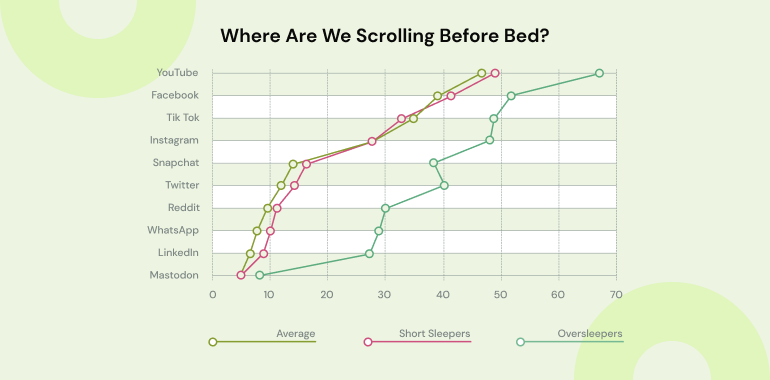
Data from Statista Consumer Insights shows that the United States is in the top 5 countries where people have problems with sleep (falling asleep, staying asleep, insomnia, etc.) in the last 12 months, with a share of 39% of people who cannot sleep normally [10].

According to estimates by National Heart, Lung, and Blood Institute (NHLBI), 50 million to 70 million people in the U.S. have ongoing sleep disorders [11]. Furthermore, in 2023, 9%-15% of U.S. adults have insomnia that affects their daytime activities [12].
Taking a closer look at the portrait of Americans who had trouble falling asleep and those who had difficulty staying asleep, we can see that the audience has some demographic differences. According to the National Center for Health Statistics in 2020, Women (17.1%) were more likely to have trouble falling asleep than men (11.7%), and women (20.7%) were more likely than men (14.7%) to have difficulty staying asleep. In addition, the percentage of adults who had trouble falling asleep decreased with age. In contrast, the highest rate of adults who had trouble staying asleep is among 45-64 years old [13].
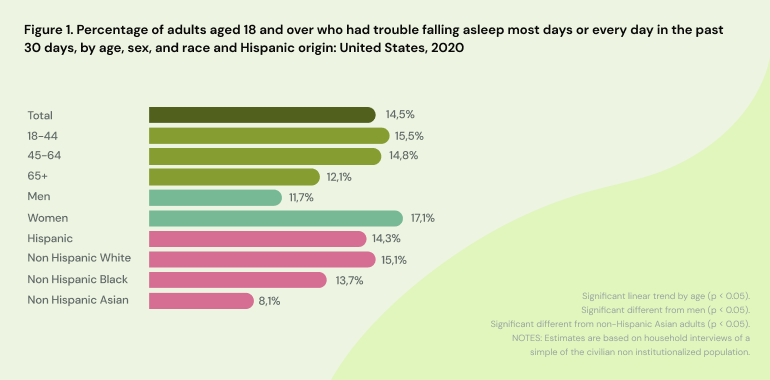
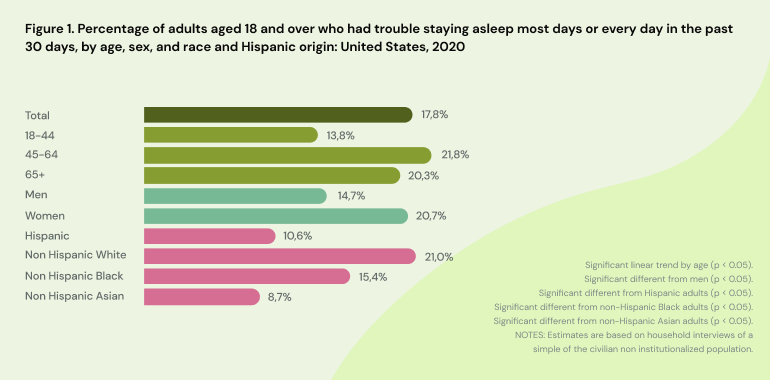
The problem with sleep is so urgent that it affects the economy. Lack of sleep causes unplanned absences from work, which cost the U.S. economy $44.6 billion each year, due to the Gallup Report in 2022 [14].
However, people are willing to work on improving their sleep with sleep aids.
According to Statista, in 2022, 21% of Americans open a window or use air conditioning to enhance sleep, 11% used non-medicated sleep aids such as tea or melatonin, and about 8% of adults in the United States reported using prescription medications to improve their sleep [15].
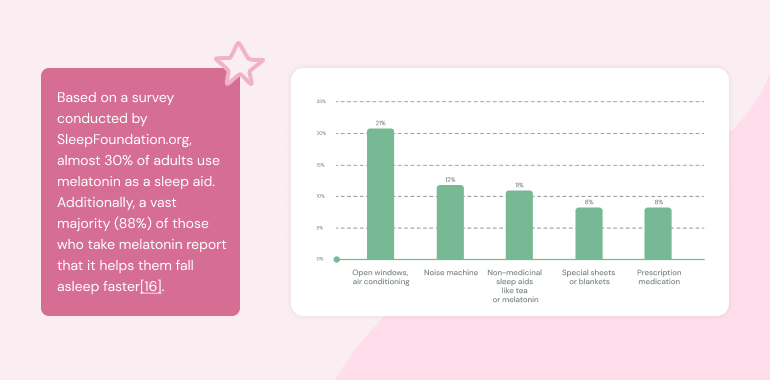
Based on a survey conducted by SleepFoundation.org, almost 30% of adults use melatonin as a sleep aid. Additionally, a vast majority (88%) of those who take melatonin report that it helps them fall asleep faster.[16].
Nowadays, many apps can monitor your physical activity, heart rate, and sleep. The United States is one of the top five countries where people use sleep-tracking apps. About 15% of American adults have used sleep-tracking apps in the past 12 months, due to Statista Consumer Insights [17].
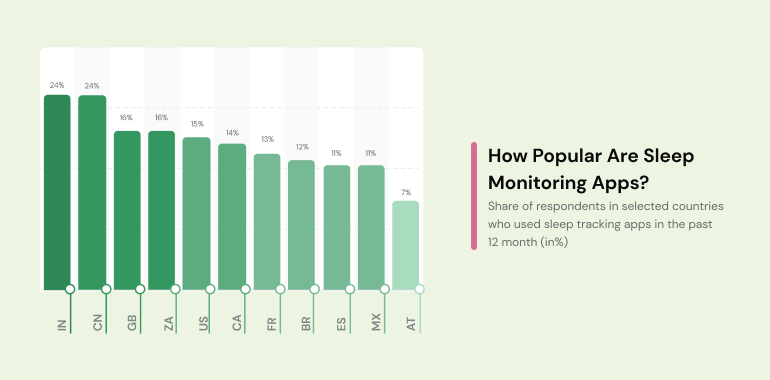
Americans are constantly trying to improve their sleep, and what else are they willing to do to get a good night’s rest? The latest Sleep Quality Survey by U.S. News & World Report found that many Americans are eager to make sacrifices to improve their sleep. For example, 38% of those surveyed said they would give up eating out for a month if it meant better sleep. 28% were willing to skip social gatherings and meetings with friends for a month. 27% said they would go without TV or movies for a month, and 25% said they would give up listening to music for a month [4].
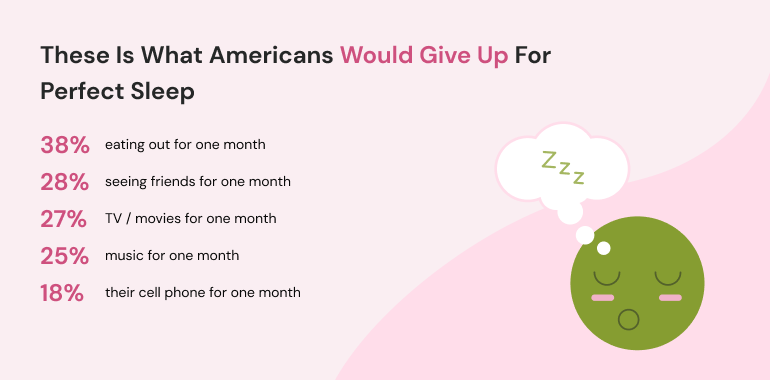
Sources
- (2020). Physiology, Sleep Stages by Patel, A. K., Reddy, V., & Araujo, J. F., 2020, U.S. https://www.ncbi.nlm.nih.gov/books/NBK526132/
- SleepFoundation.org, Sleep Statistics, 2023, U.S. https://www.sleepfoundation.org/how-sleep-works/sleep-facts-statistics#references-83522
- Gallup poll, Sleepless in the USA, 1942 vs 2013, U.S. https://www.statista.com/chart/26201/americans-reporting-sleeping-six-hours-or-less-per-night/
- U.S. News & World Report Sleep Quality Survey 2022, U.S. https://www.usnews.com/360-reviews/sleep/americans-sleep-quality-habits-survey
- County Health Rankings & Roadmaps report, 2022, U.S. https://www.sleepfoundation.org/sleep-news/why-cant-hawaii-sleep-best-worst-for-insufficient-sleepers
- SleepFoundation.org survey, August 2022, U.S. https://www.sleepfoundation.org/sleep-news/one-third-of-adults-lose-sleep-to-sunday-scaries
- American Academy of Sleep Medicine Sleep Prioritization Survey 2022, Sunday Scaries. Feb. 17-24, 2022., Retrieved September 14, 2022, U.S. https://www.sleepfoundation.org/sleep-news/one-third-of-adults-lose-sleep-to-sunday-scaries
- SleepFoundation.org survey, Why Are We All Still Watching TV Right Before Bed?, June 2022, U.S. https://www.sleepfoundation.org/sleep-news/watching-tv-before-sleep-most-popular-bedtime-routine
- OneCare Media, February 2023, U.S. https://www.sleepfoundation.org/sleep-news/how-often-do-we-eat-before-bed https://www.sleepfoundation.org/sleep-news/how-does-social-media-affect-sleep
- Statista Consumer Insights, Survey about Sleep, 2022, Global https://www.statista.com/chart/29517/share-of-adults-that-have-trouble-sleeping/
- National Heart, Lung, and Blood Institute (NHLBI). (2022, March 24). Sleep deprivation and deficiency. Retrieved March 29, 2023, from https://www.nhlbi.nih.gov/health-topics/sleep-deprivation-and-deficiency
- Kline, L. R. (2023, January 13). Clinical presentation and diagnosis of obstructive sleep apnea in adults. In N. Collop (Ed.). UpToDate., Retrieved March 27, 2023, from https://www.uptodate.com/contents/clinical-presentation-and-diagnosis-of-obstructive-sleep-apnea-in-adults
- National Center for Health Statistics, National Health Interview Survey, 2020, U.S. https://www.cdc.gov/nchs/products/databriefs/db436.htm
- Gallup, Inc. (2022, April 18). Casper-Gallup State of Sleep in America 2022, U.S. https://www.gallup.com/analytics/390536/sleep-in-america-2022.aspx
- Statista, Sleeping aids used by adults, 2022, U.S. https://www.statista.com/statistics/1310940/sleeping-aids-reported-by-adults-us/
- SleepFoundation.org survey, How Much Melatonin Do We Really Take?, September 2022, U.S. https://www.sleepfoundation.org/sleep-news/how-much-melatonin-do-adults-really-take
- Statista Consumer Insights, How Popular Are Sleep Tracking Apps, 2022, Global https://www.statista.com/chart/29518/share-of-people-that-say-they-have-used-sleep-monitoring-apps/
Mia Wang is Ph.D. in Nutrition. Passionate about helping others achieve their health goals through evidence-based nutrition and lifestyle solutions.





